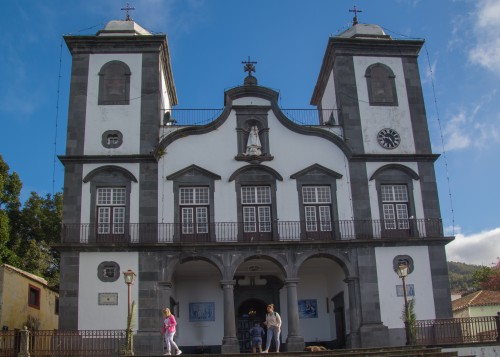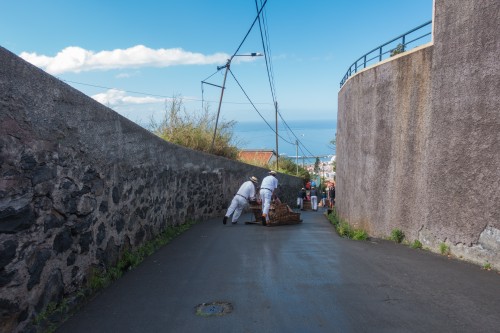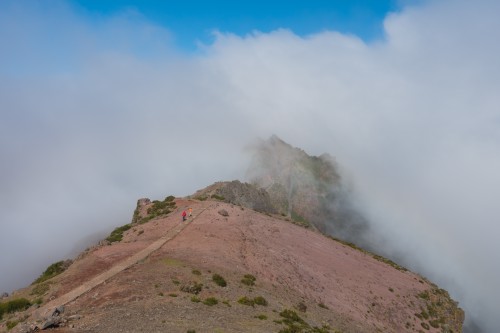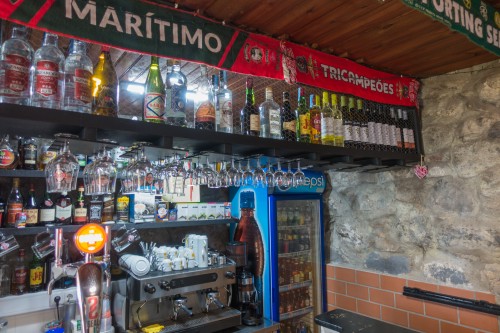

Despite going to bed at a decent hour, we were up most of the night. We finally got back to sleep around 6am, only for our alarm to go off at 6:45am. The boat was still moving, but we could see the island of Madeira and lights in what we assumed was Funchal, the capital. We got ready for our excursion, Justin packing his camera bag and Crystal packing a small backpack with stuff we might want or need. We then grabbed some water and got some pastries from a coffee shop at the back of the 7th floor. Out on the patio behind the coffee shop, we ran into Bernard from Perth again.
We were docking the ship at the pier, and we could see there was a “CR7” museum right on the pier for Cristiano Ronaldo, the famous Portuguese futbol star (and who wears the number 7). He was born in Madeira, so it shouldn’t have been surprising there was a museum here. There was also a statue of him we could see outside the museum, which immediately made us think of the comically bad bust of Cristiano that was unveiled a couple years ago at the Madeira airport, which looks absolutely nothing like him. In addition to the museum we could also see buildings terraced all the way up the fairly steep hillsides, well into the hills.
 |
 |
We got off the ship right after the gangway opened at 8. We were waiting for an 8:30 pickup from a local guide named Valdemar. In looking up tours at the various ports, we did a lot of research on private tours, small group tours, looking up local travel agencies, etc., and at some point Justin stumbled upon a website called www.toursbylocals.com. On that site, for a given location, it returns a list of local guides and local tours in that area. There’s also the ability to contact the local guides and see if they can answer questions or arrange custom tours. So for everywhere we could, we contacted local guides with a “wish list” of things we wanted to see and do, and gauged their fit for us from their responses. Some were much more verbose and enthusiastic in terms of what could and couldn’t be done, and what would make for a good trip, and we tried to book with those folks if possible. We’d arranged tours through Tours By Locals for today in Madeira, plus both days in Tenerife, the day in Gran Canaria, the day in Lanzarote, and the day in Tangier.
We had booked through the cruise ship for Casablanca and Malaga, so that just left El Hierro and Fuerteventura. El Hierro is a tiny island with very few tourists, so finding anything for there, especially on English websites, was near impossible. We spent endless hours searching until we finally found a tour operator, Cantour, who provided day trips to El Hierro from Tenerife. We contacted Cantour to see if perhaps they might know a local guide on El Hierro that might guide those day trips from Tenerife, and sure enough they did, and arranged for a guide on El Hierro to guide us there. Fuerteventura was a bit easier, with a local tour company offering a “best of the island” tour, and we booked with them. But literally the morning we were leaving from San Diego, they told us there had been some sort of a mix-up and couldn’t do the tour that day. That left us in a pickle, as we had no time to arrange anything else, and now we were on the ship with very limited and cumbersome internet options.
 |
 |
So as we were standing at the pier here in Funchal waiting for our guide to show up, we spoke to Claudio about any ideas he might have for things to see and do in Fuerteventura. He recommended anything with a volcanic landscape, telling us that Fuerteventura had a lot to offer in that regard. As it got closer to 8:30, we started to get worried a bit, as we had never used Tours By Locals before and had no idea what to do if our guide didn’t show up. But then Valdemar showed up at 8:31 in a Land Cruiser. He introduced himself, then took the roof off of the back of the vehicle and told us to hop in the back. He told us we had the ultimate freedom to adapt our trip today, depending on the weather and what we were most interested in. He had planned to start in the middle of the island, then go to the north and then the east, coming back to Funchal in the afternoon where we could check out the Botanic Garden and ride on one of the wooden “sledges” down from Monte to Funchal.
We told him what we’d heard Claudio told everyone the day before, which was that since it was Good Friday, the sledges were being run only from 9am to 1pm, and so we wouldn’t be able to do that later in the afternoon. Valdemar thanked us for that piece of information (and thanks to you, Claudio!), and immediately adapted the plan, telling us we should start with that and then go to the mountainous middle of the island. So we hopped in the car and started going up the hills from Funchal into Monte, just above Funchal. At Monte, we hopped out and walked around a bit.
 |
 |
The plants in Funchal and Monte were a lot like San Diego, but slightly more tropical. There were African Tulip Trees, Jacarandas, Tree Ferns, Agaves, Aloes, Dragon Trees, Pride of Madeira, Passionfruit vines, Kentias, Bougainvillea, and more. In Monte, we briefly checked out a church, The Church of our Lady of Monte, that out front had a statue to the last Hapsburg ruler of Austria-Hungary, Charles I. When Franz Ferdinand was assassinated, Charles became the presumptive heir of the empire. He ruled after Franz Joseph died in 1916, but ruled for less than two years before “renouncing participation” in the affairs of the Empire. He specifically did not abdicate – hoping he’d be asked back at some point – but that never happened. A bit later the Austrians dethroned and banished all of the Hapsburgs, and he and his family meandered their way through Europe before reaching their final spot of exile in Madeira. Valdemar told us a bit about him, and also that Empress Sisi had visited Madeira several times, which we remembered from the Sisi Museum in Vienna on our trip last Christmas.
 |
 |
 |
 |
We walked around for 30 minutes or so whilst Valdemar told us about the history of Madeira. He also told us about the local economy and tourism, stating that the visitors were mostly “newlyweds and nearly deads.” We walked near some panoramic lookouts, near the funicular stop that brings people up from near the pier. We could see it was sunny down at the bottom by the ocean, but cloudy at the top of the mountains. We walked past the Botanic Garden and it looked nice, but didn’t look so interesting or unusual for us to stop in. We got in line for the sledge, and Val left to take photos of us halfway down. The ride down lasted about six minutes. The process is more organized and regulated than it used to be. The road is now paved instead of cobblestoned, and there are people blocking off traffic at all of the intersections where the sledge road intersects other streets. The sledge has animal fat on the bottom to help avoid friction, but we could still see slivers of wood everywhere. It was pretty fun, and definitely worth doing for anyone visiting Funchal.
 |
 |
 |
 |
When we were done, we got back in the car and headed into the mountains in the center of the island. On the way out of Monte we stopped briefly at a nice viewpoint of our ship with a large Dragon Tree. Val told us that the island used to be covered in them, but almost all of them were cut down a few centuries ago by people who sold the bright red sap as “Dragon’s blood.” From research we’d done and some YouTube videos we’d seen, we got the impression that the center of Madeira was a bit like the center of Kauai, with a lot of deep valleys and jagged mountains. We were hoping to do some hiking in that area. But, also similar to Kauai, the area is often cloudy and windy, and so hiking is far from a sure bet.
 |
 |
About halfway up to Pico de Areiro, one of the main lookout points, we were in the clouds, and it was not much fun with no roof. Val had told us to tell him if and when we wanted him to put the roof back on, but we just braved it out, figuring we’d be there soon enough. We got back in the sun, above the clouds, right near the top. But even in the sun, it was very cool and windy, even with our jackets on. We could make out a bit of the landscape as the wind blew clouds away, but just enough to whet the appetite. While we would have loved to do some hiking, it was not really possible and we would have frozen to death in the cold wind.
 |
 |
So we left Pico de Areiro after just a brief stop, and went off roading a little bit, through a native pine forest. The pine forest used to be all over continental Europe, but died out in the last ice age, so now it exists only in Madeira and the Canary Islands. The cobblestone road was the “royal road” from many centuries ago, when the various villages on the island were connected by these small roads. Nowadays these roads get used by hikers, 4x4s, and ATVs, some of which came up behind us and passed us after a bit. We saw some of Madeira’s famous “levadas” near some of the roads, including some bridges. The levadas are kind of analogous to aqueducts, transporting water all over the island from the wetter center and uphill to the drier coast. Madeira has enough water for all its people at all times of the year, even during the dry season, because the prevailing winds from the north blow clouds onto the north facing mountains where even if they don’t drop rain, the clouds are thick enough to condensate, just as they were doing to us today.
 |
 |
 |
 |
We stopped a couple places along the roads, including one spot where Val grabbed for us a banana passionfruit. The fruit didn’t taste like banana, but rather was shaped like a banana. We’ll have to check if there are any of that variety in Hawaii. The island vaguely reminded us of Kauai with all of the v-shaped valleys that we were traversing, but it reminded us more of Hiva Oa and the other Marquesas islands, especially with the small villages in the valleys we kept coming across. It might have reminded us of Hiva Oa also because our private tour with a local resident was quite like the tour we had on Hiva Oa back in 2015. Eventually we ended up in Santana on the north side of the island, which is famous for its traditional homes with thatched roofs, very few of which still exist on the island. Val showed us a couple and we were going to check some more out, but then it really started to legit rain, so he put the roof on the vehicle. While he did that we noticed some King Proteas at one of the homes we were parked near.
 |
|
 |
 |
Back in the vehicle, Val promised us he’d try to find us some sunshine, so we headed out east. Our first stop was at a large bay in Porto da Cruz, where there was a rum distillery (North Mills Distillery) and a harbor. Val recommended we try the Sorum Madeira, the local rum, if we had a chance. After we’d stopped, Val took the roof back off since it’d stopped raining, and we headed even further east, out onto a small peninsula at the far east of the island. As we approached the end of the road at Ponta de Sao Lourenco, we were finally back in the sun, and we stopped for a while to check out the cool rock formations, with red ash and black lava striations from where the dykes had been.
 |
 |
 |
 |
From there we drove a short distance to Canical, where we drove past the fairly sizable port with a dry dock. We stopped at Tasca do Samao to get one of the local drinks, a cocktail with rum, local honey (one of Madeira’s main exports), and citrus. We also had a snack made of some sort of bean that was related to a broad bean, and had some sort of garlic-type sauce that they’d been tossed in. Val told us that there was basically no nutrition in these beans, and so they were empty calories, basically zero calories. We’re somewhat dubious, but they were tasty in any event.
 |
 |
From Canical we got on the main highway on the south coast. Val told us that there were lots of new roads built on Madeira in the last 20-25 years, and drives of several hours had been reduced to 30-45 minutes. Seeing some of this new infrastructure (long tunnels, big highway interchanges), it seemed to us like a ton of infrastructure costs per capita, and we wondered where the money came from. Perhaps all the tourism funds it directly or indirectly through taxes. One of the biggest infrastructure costs was a massive extension of the airport runway, which had to be built on a giant raised platform since there was no flat land. We drove underneath the runway, which was something you don’t often see.
 |
 |
Just east of Funchal we passed by the town where there’d been the bus crash a few days prior. Val told us that it had been mechanical failure, as the bus was on a safe road with an experienced driver. Apparently he couldn’t get the bus to slow down, and some failure with the transmission prevented him from downshifting into the lowest gear, so he tried to brush the bus up against a wall to slow it down that way, but it didn’t work and eventually the bus tumbled down a hillside. Val lamented that when Madeira ends up in the news, it’s nearly always for unfortunate reasons. As we approached Funchal and could see the harbor, Val told us about the yearly fireworks show on New Year’s Eve. Apparently a number of barges and cruise ships go out into the harbor and fire off an insane amount of fireworks which can be seen all over Funchal and the surrounding area. We’ll have to come back for that.
 |
 |
We had wanted to check out some of the Coconut palms around Funchal, which Justin had received some information about from people on PalmTalk, but we were running low on time and had to skip this. But on the drive back to the marina we drove past some. Val actually didn’t know there were Coconut palms on Madeira, but there aren’t a ton and perhaps they don’t fruit much, in which case they wouldn’t especially stand out to someone who wasn’t a palm connoisseur. We were supposed to be back on board at 4:30 since the ship was scheduled to leave at 5:00, and we got back to the ship at 4:25. So we said our abbreviated goodbyes, then went up the gangway.
 |
 |
Back in the room, we realized we’d gotten more sun than we’d thought – apparently sitting in a vehicle with no roof does that. We were a bit dehydrated, no doubt in part due to all the sun our skin had received, so we went to the coffee shop at the back of 7 to get tea (Crystal) and water (Justin). We actually backed out of the port, so this took a decent amount of time. Whilst we were backing out, Justin could make out a good number of Coconut palms along the embarcadero. None appeared to be fruiting. After backing out, we turned south and headed out towards the Canary Islands. There were lots of seabirds, at first because of the water we were churning up, but later because we realized one of the employees was throwing bread pieces from one of the top decks.
 |
 |
 |
There was a “block party” at 6pm in the hallways, for people to meet their neighbors. We met Bob and Diane (from Jacksonville) and Andy and Janet (from Houston). Bob warned us about an elaborate pickpocket ruse in Barcelona, where people shot some sort of a liquid through a straw that appeared to be bird poop, and then a colleague “helped” clean the bird poop off the shoulder whilst pickpocketing. So Bob told us to be careful when we got to Barcelona. Both couples had been on Seabourn cruises 4 times, so we felt like rookies.
 |
After the block party ended we went up to the Observation Bar, which once again was pretty full. We got the last two seats, and Helder remembered us – hopefully for better than for worse. Justin got a Caipirinha, and decided to make it a South American night for his drinks. Crystal got a Vodka soda. There were some snacks, and we grabbed some potato chips, corn chips, and thin smoked ham. It was nice, but there were a bunch of loud Americans (we guessed this was time #117 we’d experienced it on our trips) that put a bit of a damper on the vibe. Everyone started emptying out around 7:30 as they went to their respective dinners. For our second round we both got Argentine Malbec. We had 8:45 reservations at Thomas Keller, so eventually we were the last ones standing (sitting) with Helder. We discussed the block party and feeling like we were the only first timers on the ship. He said no, it’s just that first-time people are generally more shy and so don’t speak up around others. Justin replied “we’re not shy, we just don’t like people.” Without skipping a beat, Helder responded “Yeah, me too.” We were all smiling.
 |
 |
Crystal knew this, but Justin had no clue, that Thomas Keller is a bit of a big deal in the culinary world, and outside this ship we’d probably not be able to (or want to afford) go to one of his restaurants. So we’d booked one night at The Grill a month or so before leaving San Diego. We were the last ones seated tonight, so they knew our name when we arrived. Damien from France was our waiter. For drinks, the first round was boulevardier for Crystal and a pisco sour (Peru’s - and Chile's - main cocktail) for Justin. The pisco sour was okay, but frankly it needed half the simple syrup. For our appetizers, Crystal got a Caesar salad and Justin got a tomato dish with olive oil. Crystal said more salt makes tomatoes taste better, and she was correct.
We both got ribeyes for our main, and we both got Chilean cab, completing Justin’s southern South America drink tour. The steaks were good, but frankly could have used more salt. We surmised that where the demographics skew older, less salt is put on food, figuring you can add salt at the table but you can’t take it away. Dessert for Crystal was a lemon meringue tart. Justin asked about the cookies he kept seeing delivered to the other tables and whether they could make an ice cream sandwich using two cookies with some ice cream in between (like at Hula Cookies in Ma'alaea on Maui). They obliged, but for some reason they put it in a glass, but Justin quickly removed it and ate it like a burger. Back at the room, Justin was tired and went to sleep almost immediately. Crystal had a glass of champagne and listened to podcasts for a bit before nodding off.
| Previous Day |